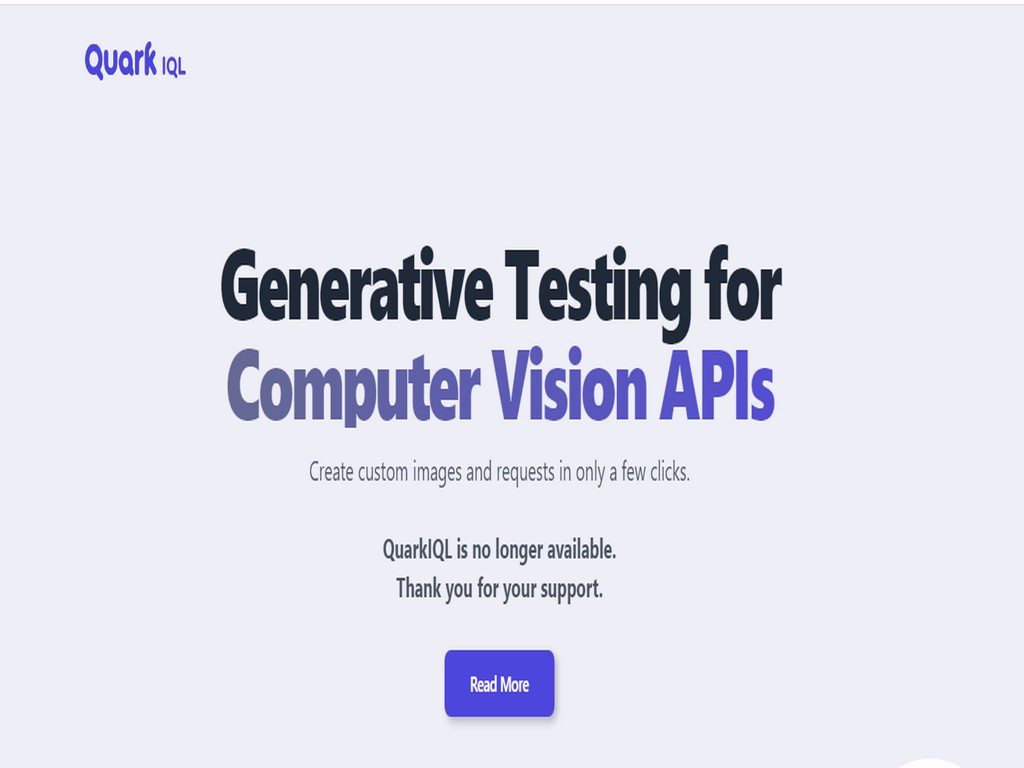
QUARKIQL: Generative Testing for Computer Vision APIs
- QUARKIQL: Imagine it as a special tool, like a magic wand, that helps people with computer stuff.
- Generative Testing: Generative testing is like asking a computer to create different tests all by itself, without needing humans to make them one by one. It’s like having a robot that can make lots of tests for you automatically.
- Computer Vision APIs: This is like giving the computer special glasses that help it see and understand pictures or videos. APIs are like a set of instructions or rules that tell the computer how to use these glasses.
So, when we put it all together, “QUARKIQL: Generative Testing for Computer Vision APIs” means that it is a special tool that helps people automatically create tests to check how well the computer can see and understand pictures or videos using its special glasses (the Computer Vision APIs). It’s like having a helpful robot that makes sure the computer’s special glasses are working properly.

Introduction to QUARKIQL
it is a user-friendly tool designed to streamline the testing process for computer programs, particularly those focused on image and video analysis. By automating the generation of various tests, it simplifies what would otherwise be a time-consuming and labor-intensive task. This tool is invaluable for developers seeking to ensure the accuracy and reliability of their computer vision systems. The introduction sets the stage by highlighting the importance of thorough testing in software development and introduces it as a solution to this challenge.

Understanding Generative Testing
Generative testing is a method that involves automatically generating a wide range of tests to evaluate the performance and functionality of software systems. Instead of manually crafting individual tests, generative testing employs algorithms or scripts to create numerous test cases automatically. This approach enhances test coverage and helps uncover potential issues that might go unnoticed with traditional testing methods. By understanding the concept of generative testing, developers can appreciate its advantages and leverage tools like it more effectively.
What are Computer Vision APIs
Computer Vision APIs are specialized software interfaces that allow developers to integrate computer vision capabilities into their applications without having to build these functionalities from scratch. These APIs provide a set of predefined functions and algorithms that enable tasks such as image recognition, object detection, and facial analysis. By leveraging Computer Vision APIs, developers can access advanced image processing capabilities without needing expertise in computer vision algorithms. This section provides an overview of Computer Vision APIs, explaining their purpose and significance in enabling the development of sophisticated visual applications.
The Need for Testing Computer Vision Systems
Testing computer vision systems is essential to ensure their accuracy, reliability, and robustness in real-world scenarios. Unlike traditional software applications, computer vision systems rely on complex algorithms to interpret and analyze visual data, making them susceptible to errors and inaccuracies. By conducting thorough testing, developers can identify and address potential issues early in the development process, thereby improving the overall quality of the system. This section explores the importance of testing computer vision systems and the potential consequences of overlooking this critical aspect of development. It emphasizes the need for comprehensive testing strategies to validate the performance of computer vision algorithms effectively.

Introducing QUARKIQL: A Solution for Testing Computer Vision APIs
QUARKIQL emerges as a cutting-edge solution to the challenges associated with testing computer vision systems. By providing a user-friendly interface and powerful automation capabilities, QUARKIQL empowers developers to create and execute tests with ease.
Unlike traditional testing methods that require manual intervention, it automates the test generation process, saving time and resources while ensuring comprehensive test coverage. This section introduces it as a game-changer in the field of computer vision testing, highlighting its innovative features and potential benefits for developers.
How QUARKIQL Works
it operates through a series of intuitive steps, starting with the selection of test parameters and criteria. Once the testing parameters are defined, it generates a diverse set of test cases automatically, leveraging sophisticated algorithms to ensure comprehensive coverage. These test cases are then executed against the target computer vision system, and the results are analyzed to identify any discrepancies or issues.
Throughout the process, it provides real-time feedback and insights, enabling developers to iteratively refine their systems for optimal performance. By understanding the inner workings of QUARKIQL, developers can harness its capabilities more effectively to streamline their testing workflows and enhance the quality of their computer vision systems.
Benefits of Using QUARKIQL
The benefits of using QUARKIQL extend beyond mere convenience, encompassing significant improvements in testing efficiency, accuracy, and effectiveness. By automating the test generation process, it reduces the time and effort required to create comprehensive test suites, allowing developers to focus on refining their algorithms and addressing critical issues.
Additionally, it’s advanced analytics and reporting capabilities provide valuable insights into the performance of computer vision systems, enabling developers to identify areas for improvement and optimization. Overall, QUARKIQL empowers developers to accelerate the development lifecycle, minimize testing overhead, and deliver robust and reliable computer vision solutions.
Real-world Applications of QUARKIQL
The real-world applications of QUARKIQL span a wide range of industries and domains, demonstrating its versatility and effectiveness in various contexts. From autonomous vehicles and surveillance systems to healthcare and entertainment, It has been instrumental in accelerating the development and deployment of cutting-edge computer vision solutions.
In the automotive industry, it facilitates the testing of autonomous driving systems, ensuring their safety and reliability on the road. In healthcare, QUARKIQL aids in the analysis of medical images and diagnostic data, improving patient outcomes and healthcare delivery. These examples illustrate the profound impact of it in transforming the way computer vision systems are developed, tested, and deployed across diverse applications.
Tips for Getting Started with QUARKIQL
Getting started with it is straightforward, but there are several tips and best practices to maximize its effectiveness and efficiency. First and foremost, familiarize yourself with the user interface and available features to navigate QUARKIQL seamlessly. Next, define clear testing objectives and parameters to ensure that your test cases align with your project requirements.
Additionally, leverage it’s documentation and support resources to troubleshoot any issues and optimize your testing workflow. Finally, collaborate with other developers and share insights and experiences to harness the full potential of it for your projects.
Conclusion: Enhancing Computer Vision Development with QUARKIQL
In conclusion, QUARKIQL emerges as a game-changing tool for enhancing the development and testing of computer vision systems. By automating the test generation process and providing advanced analytics capabilities, it empowers developers to streamline their testing workflows and deliver robust and reliable solutions.
As the demand for computer vision applications continues to grow across various industries, tools like QUARKIQL will play a crucial role in accelerating innovation and driving progress in the field. By embracing it and incorporating it into their development workflows, developers can unlock new possibilities and achieve unprecedented levels of efficiency and effectiveness in building computer vision solutions.



